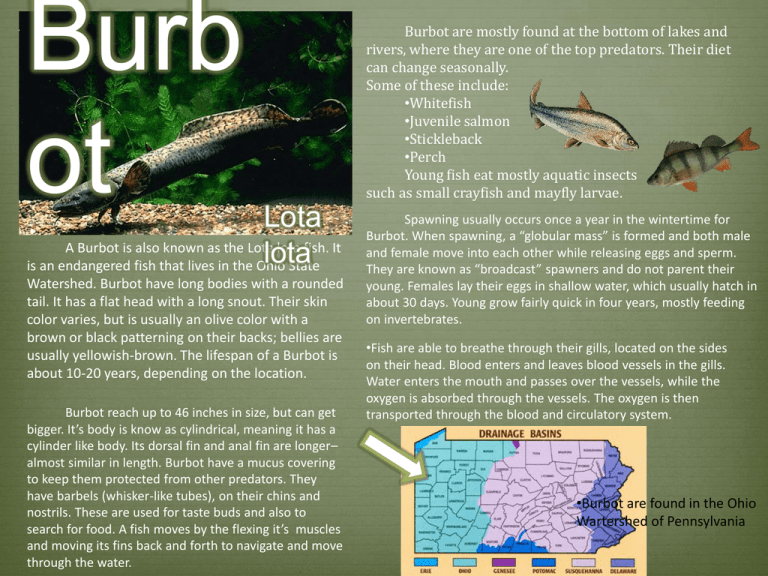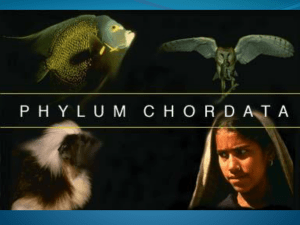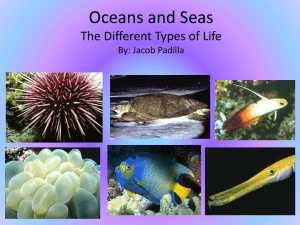
Burb
ot
(Lota lota)
Lota
A Burbot is also known as the Lota lota fish. It
lota
is an endangered fish that lives in the Ohio State
Watershed. Burbot have long bodies with a rounded
tail. It has a flat head with a long snout. Their skin
color varies, but is usually an olive color with a
brown or black patterning on their backs; bellies are
usually yellowish-brown. The lifespan of a Burbot is
about 10-20 years, depending on the location.
Burbot reach up to 46 inches in size, but can get
bigger. It’s body is know as cylindrical, meaning it has a
cylinder like body. Its dorsal fin and anal fin are longer–
almost similar in length. Burbot have a mucus covering
to keep them protected from other predators. They
have barbels (whisker-like tubes), on their chins and
nostrils. These are used for taste buds and also to
search for food. A fish moves by the flexing it’s muscles
and moving its fins back and forth to navigate and move
through the water.
Burbot are mostly found at the bottom of lakes and
rivers, where they are one of the top predators. Their diet
can change seasonally.
Some of these include:
•Whitefish
•Juvenile salmon
•Stickleback
•Perch
Young fish eat mostly aquatic insects
such as small crayfish and mayfly larvae.
Spawning usually occurs once a year in the wintertime for
Burbot. When spawning, a “globular mass” is formed and both male
and female move into each other while releasing eggs and sperm.
They are known as “broadcast” spawners and do not parent their
young. Females lay their eggs in shallow water, which usually hatch in
about 30 days. Young grow fairly quick in four years, mostly feeding
on invertebrates.
•Fish are able to breathe through their gills, located on the sides
on their head. Blood enters and leaves blood vessels in the gills.
Water enters the mouth and passes over the vessels, while the
oxygen is absorbed through the vessels. The oxygen is then
transported through the blood and circulatory system.
•Burbot are found in the Ohio
Wartershed of Pennsylvania
American Eel
Anguilla rostrata
•
•
•
•
•
•
Their eggs hatch in 9 to 10 weeks
Has a long nose
Swims with just it’s tail because it’s body is
long and slender and has no bones or feet
They can be found in the rivers and bodies
of water throughout the east coast and
Bermuda region of the Atlantic Ocean
They spawn in salt water
They are nocturnal
•
•
•
•
•
They hunt at night and hides
during the day
It ways 9.25 pounds
Rounded tail
They are a sport fish, people also
eat them
The eel can be found in the Ohio,
Potomac, Susquehanna and
Delaware river basins
muskellunge
The muskellunge (Esox Masquinongy) has a long, wide
snout with many teeth designed to hold prey. It has
large eyes which are high and forward on the head. It
has an elongate body and the dorsal and anal fins are
located further back on the body, providing a large
amount of fin surface allowing the fish to propel its self
forward quickly. The muskellunge spawn from the
middle of April to late may in shallow bays with rock
bottoms full of vegetation. It takes two weeks for the
eggs to hatch into fry that will eat zooplankton for the
first few days of life but then switch to live fish. Males
reach maturity at four to five years while females grow
faster and reach maturity at five to seven years. The
musky moves by using its powerful tail muscles to
propel its self forward while keeping its body fairly
straight allowing it to be quicker and more powerful.
Esox
Masquinongy
When the musky is just hatched it feeds on zooplankton but
in just days it prefers to eat fish. The muskellunge’s diet
consists mostly fish from the size of minnows to whatever
they can fit in their mouth, but they have been know to eat
snakes, ducks, and rodents. A unique characteristic of the
musky is the body pattern which is a very light color with
dark spots allowing it to blend in perfectly with its
environment making it such a great predator. The musky
breathes through gills which take the dissolved oxygen
from the water and transfer it into the bloodstream.
The musky prefers a habitat of both deep and shallow pools filled
with vegetation and cover which would allow the fish to ambush its
prey and take it back to cover before eating it. The preferred water
temperature is 33 to 77 degrees farenheight.
The musky stays in its preferred home range and habitat which
in Pennsylvania is the Erie, Ohio, Potomac and Delaware water
basins.
Pink Salmon
Pink salmon make nests. The
female put out an area by lying
on her side, moving the gravel to
the side. Some pink salmon redd
can be as deep as a foot or
December through February. The
young feed on the yolk sac in the
redd until the yolk sac is
absorbed more and three feet
long. The female make about
1,500 to 1,900 eggs. Females
watch their nests until they die.
A few days after spawn. The
eggs hatch from. In April or
May, the newborn pink salmon
swim downstream to Lake Erie.
Pink salmon spawn at about age
2. It may reach up to 24 inches in
the ocean, but sometimes more
than 18 to 20 inches in fresh
water. It moves by flexing its
muscles of the fins. They eat a
variety of fish.
Princess Chantelle<3(:
It has large, dark, oval spots on the adipose
fin, tail and the upper sides of the body. The
upper surfaces are blue to blue-green. A
noticeable hump appears on the back between
the head and dorsal fin. The sides are silvery
and in breeding males become pale-reddish
with greenish-brown blotches. Breeding males
also develop elongated jaws, the upper one
longer and hooked downward.
Pink Salmon live in both the Atlantic and
Pacific Oceans, as well as the Great Lakes and
other land locked lakes.
•Filter feeder
•Zoo plankton and aquatic insects
•Copepods and ostracods make up most of the diet
•Mouth has gill arches containing filaments: allowing them to get zoo plankton out of the water
•Has no teeth
•Found in Erie and Ohio drainage basin of PA
•Have them at Lamar fish hatchery
•Live long; surviving over 30 yrs.
•Mature later than most fish, sometimes at 10 yrs. Or older
•Can attain sizes of over 7 ft. long and more than 200 lbs.
•Freshwater fish; survive in murky waters; slow-flowing water- usually at depths greater than 1.3 m
•Suffered from legal and illegal harvesting in the past- meat and eggs sold as caviar
•Threatened now by habitat destruction and river modification
•Nose is called the paddle or a rostrum. Used for sensing zooplankton.
Striped Bass
Morone saxatilis
Spawning takes place near
the surface of the water around
5 or 6 feet. The water has to be
moving current for better
spawning. Most spawning takes
place from 60-67 degrees F.
Although some can be at 55
degrees F. Females normally lay
about 65,000 eggs at one time.
The eggs float freely in the
water for about 2 or 3 days
before they hatch.
Striped bass are found in the
Susquehanna, Delaware, and
Genesee.
The striped
bass has a bilateral
symmetry. Like most
other boney fish they
mainly use their tails
to move and fins for
balance. They seem
to have a slim body
until they reach
about 10-15 pounds
then they have a
heavy look. They
normally have about
8 black stripes
running down their
body.
The striped bass migrate
from they’re salt water homes
into fresh water streams only
two times in their life. Once to
lay eggs and again 2 years after.
They are high up on the under
water food chain and will eat
just about anything. They start
off just eating little things but as
they grow their diet changes
into eating many other fish.
The striped bass can live in
salt water or freshwater. They can
also live in moving or still water.
Striped bass prefer to live in cleaner
waters. In the summer they like to
stay in deep water but when fall
comes they like to stay in shallow
water.
The striped bass like
almost every other fish
breaths with girls. As water
flows through the girls it
sends oxygen into the lungs.
Then that oxygen is
transferred to blood then
through out the fishes body.
Desiree Cunningham pd. 4
9.5 cm – max size 7 cm –
Blue Spotted sunfish
Enneacanthus gloriosus
Atlantic slope drainages and
Delmarva Peninsula
eats Insects and invertebrates
Mainly live in Virginia
Spawns from May to September
Nests in shallow areas like
depressions in the sand or under
aquatic plants
Every female lays about 600 eggs
Moves with it’s fins
Looks similar to the bluegill
Called Blue Spotted because of
it’s metallic blue spots
Has bilateral symmetry
common
Demersal - living or found near
or in the deepest part of a body
of water; freshwater
Lives in vegetated lakes, ponds,
quiet sand and mud-bottomed
pools and backwaters of creeks
and small to medium rivers;
Atlantic slope drainages and
Delmarva Peninsula
Insects and invertebrates
Mainly live in Virginia but can be
found in New York
Spawns from May to September
Works Cited
http://www.fishbase.org/Summary/S
peciesSummary.php?id=3368
http://www.aquaculturestore.com/sp
e_Enneacanthus_gloriosus.html
http://www.cnr.vt.edu/efish/families/
bluespotsun.html
The Channel
Catfish
The channel catfish’s
scientific name is
(Ictalurus punctatus).
Channel catfish spawn in
late spring or early
summer when water
temperatures reach 75°F.
Males select nest sites
which are normally dark
secluded areas. Like under
rocks and under banks or
logs. Wild populations of
catfish may spawn as early
as late February or as late
as August depending on
the location.
A channel catfish’s habitat is most likely to
be in a large stream with low to medium
current. They are usually found where the
bottoms are sand, gravel or rubble, but
prefer muddy bottoms.
Most movement and feeding activity
occurs at night just after sunset and just
before sunrise. Channel catfish usually
feed near the bottom in natural waters but
will take some food from the surface.
adults have a much more varied diet
which includes insects snails, crawfish,
green algae, aquatic plants, seeds and
small fish.
Symmetry: The gilt darter has
bilateral symmetry which means
that if you would cut the fish in half
they would have an eye on both
sides, fins on each side, etc.
Growth and development:
The gilt darter reaches three
inches in length. There is a
row of specialized scales
along the midline of the
belly, and the gill membrane
is joined forward of the
breast. The body ranges in
color from olive to bluegreen. Breeding males
develop five to eight bluegreen vertical bands, bright
red blotches on the sides,
and an orange breast,
orange dorsal (back) fin, and
dark blue pelvic and anal
fins.
Gilt Darter
Percina evides
Nutrition: Insect larvae,
crustaceans, and other aquatic
invertebrates.
Motility: The Gilt darter will use its
bottom fins to hold itself on the rocks
in the rivers bottom. The Gilt Darter’s
caudal fin will help the fish maneuver
itself through the water.
Circulatory and Respiratory Systems:
Water enters the gill chamber through
a fish’s mouth and exits through all
openings under the operculum. The
blood that is flowing through the gill
filaments absorbs oxygen from the
water. The lung is surrounded by veins
that bring blood to be oxygenated. The
fish will then expel CO2.
The Gilt Darter is a
threatened fish. The Gilt
Darter lives only in the
Ohio water region, which
is the light greenish blue
color shown on this map.
Reproductive Habits:
·
Mature around age 1
or 2
·
Spawning occurs May
to July in water 17-20°C
·
Spawn in sand and
gravel in riffles
· Emily
Buries
its eggs
Embick
North America: Great Lakes and Mississippi River basins from New
York and Maryland to eastern Kansas and Oklahoma in the USA, and
from Ontario in Canada south to Georgia, Alabama and Arkansas in
the USA; and Atlantic Slope in Mohawk, Susquehanna and Potomac
drainages in New York and Virginia, USA
They swim in temperate waters, at 4°C - 18°C - Low to moderate vulnerability – They’re harmless to humans - Minimum
population doubling time 1.4 - 4.4 years - Distinct pairing during breeding - Eggs are found attached to the substrate
unguarded
Erie | Ohio | Genesee | Potomac | Susquehanna
Insects and some snails - Spawning occurs late March to early May - Mature by age 1 or 2 - Eggs attach to
vegetation and rocks - Clear, rocky streams and rivers in riffles and runs, usually around vegetation – They
swim using their caudal fin and pelvic fin.
Ravynne Stroup
Per. 4
Works Cited
•http://www.fishbase.org/Summary/SpeciesSummary.php?id=
3402
•http://www.outdooralabama.com/fishing/images/DarterGree
nside400A.jpg
•http://www.dnr.state.oh.us/Portals/9/Images/fishing/fish/Male
%20Banded%20Darter%20from%20Big%20Darby%20Creek
%2010APR2009%20by%20BZ.jpg
•
•
Warm, rocky streams and rivers in riffles and runs
with swift currents, near vegetation
Found in the Big Sandy and Tennessee drainages
Mature by age 1 or 2 Spawning occurs March to midJune Eggs attach to vegetation and lay 80-262 eggs
per female
The banded darter is one of the more
frequently darter species found in Ohio. Like
many darters breeding males are very brightly
colored . Females are duller.
Found in Erie, Ohio and the Susquehanna
river
The banded darter has a
short and stubby body
shape.
They also have 4-7 darker
saddle markings over their
back and a distinct dark
teardrop marking under
the eye.
Breeding male banded
darters have 8-13 bright
green narrow vertical
bands from just behind the
head extending to the base
of their tail.
Banded darters lay•
their eggs in mid
April to mid May in
swift riffles. They lay
them in mosses that
back and upper
grow on the surface
sides olive-brown
of rocks. Once the
with 6 - 7 dark
eggs are laid the
brown cross bars,
sides covered
male guards the
with dark green
area for a short time
bars with yellowbut provides no
white belly, dusky
further parental care bar beneath the
eye and another
for the young.
extending forward
swims around ad
from onto snout.
uses it’s fins to guide
them.
http://www.fish.state.pa.us/pafish/fishhtms/c
hap23.htm#bandart
Growth and Development: spawning occurs in spring,
the water is approximately 41-50 degrees, males
protect young even after they can feed themselves.
They grow to be 4 ½ inches long, although most adults
are only 2-3 inches long. Very little has been found on
their growth rate.
UNIQUE FACTOR:
MALES TURN ALMOST COMPLETELY BLACK DURING
BREADING!!!
Grass Pickerel Americanus Vermiculatus
The Grass
Pickerel live in
The pickerel uses the back half of its body to
slow moving
move in the water. It can weight up to 10 lbs.
streams.
and reach 15ins.
A Stream
with a dense
abundance of
aquatic
vegetation. It
feed on small
aquatic
animals and
vegetation.
It lives in every
water gap
except Erie,&
Ohio.
Suited of slow
moving water
ways
Reproduction Female
lays eggs male fertilizes
the eggs
It takes
water over
its gills for
oxygen.
Quillback
Carpiodes cyprinus
--The quillback lives in the Susquehanna, Delaware, Erie, and Ohio
rivers.
-They can be found throughout the lake but are most common in
depths of 15-25 feet.
-The central quillback is found throughout inland Ohio in medium to
large streams.
-Quillback’s lay their eggs between early April and late May.
-The eggs are randomly deposited over a sand or mud bottom and
left in quiet water.
-Females lay between 15,000 to 60,000 eggs.
-Foods: Filamentous algae, and small crustaceans.
The Pumpkinseed Fish is usually about 6-8 inches long and
weighs less than 1 lb. It sides are speckled with orange, yellow,
blue, and emerald spots. Its breast and belly are normally
orange to orange-red. The fish have an oval silhouette and
are very compressed laterally; it is this body shape, looks like
the seed of a pumpkin, which provides them with their
common name. They have sharp spines in the dorsal and anal
fins.
Pumpkinseeds can be found in shallow, cool to warm
water. They are most likely in small lakes and ponds or
weedy bays of larger lakes. Preferring cover of some type,
such as aquatic vegetation or underwater brush, they are
rarely found in open water. Preferred water temperatures
range from 75 to 89 degrees F. Groups of young fish swim
close to shore, but adults tend to travel in groups of 2-4 in
The Pumpkinseed fish has a circulator and respirator system as
deeper, but still covered waters. Pumpkinseeds are active
any other fish.
throughout the day, but they rest at night near the bottom
They build nests in bluegill nest colonies, and the two species will
or in protected areas in rocks or near submerged logs.
interbreed. Females arrive after the nests are done. At first the
tremendously popular with anglers of all ages. They are
females appear to be chased away from the nest by the males,
originally from the Great Lakes. This fish is found in Lake Erie,
but after an amount of time, the females head toward the nest
Genesee River, Susquehanna River, Ohio River, Potomac
instead of away from it. Once the female is in the nest, the fish
River, and the Delaware River.
swims in circles side by side, with the bellies of both fish touching.
The male then releases sperm and the female releases eggs.
Females produce 1,500 to 1,700 eggs, depending on their size
and age. Females leave the nest after spawning, but males
remain and are highly protective and guarding the eggs. The
male guards them for about the first 11 days, returning them to
the nest in his mouth if they try to leave. Fathers may even nip at
people’s hands or feet that come close to their nests. The young
stay on or near the shallow breeding area and grow to about 2
inches in their first year. Sexual maturity is normally achieved by
age 2. These fish have lived to be 12 years old in captivity, but in
nature most do not exceed 6-8 years old.
Pumpkinseeds eat a diet of small prey, such as insects, insect
larvae, mollusks, snails and other crustaceans, also other small fish.
They are effective at destroying mosquito larvae. They feed at all
water levels from the surface to the bottom, and they feed
throughout the day. All fish that eat other fish will eat
pumpkinseeds, and large pumpkinseeds will eat smaller
pumpkinseeds. Pumpkinseeds are accustomed to being low on
the food chain, so they reproduce rapidly.
Redfin Pickerel
•
Smallest member of the pike family.
Exceeds 12 inches at most.
Greenish grey to dark olive bronze on
the back with shading down over the
sides with squiggly looking looking
lines, belly is yellow tinted snout short
and tiny, fins are red.
•
Found in shallow water, weedy , slow
moving streams, prefers water to be
clean but can pretty much put up with
any kind of water. Spawn in spring
when water temperature reaches at
least 50 °. The eggs are sticky and they
end up in shallow water and hatch in 2
weeks.
•
This fish feeds on crustaceans, crayfish,
aquatic insects.
Pike eggs are abandoned by the parents
and hatch in 10 to 12 days
Live in lakes, swamps, and backwaters,
and sluggish pools of streams. Occur
usually among vegetation in clear
water
In winter, they are found associated
with dead leaf litter
Teeth moderately large
This is the smallest member of the family and
the only
one not considered an important sport
fish
St. Lawrence River west through Great
Lakes and south to Gulf coast from FL to
TX; absent from Appalachian Mountains.
Esox americanus vermiculatus
Walleye have a long roundish body, a
forked tail and sharp teeth. This fish can
be different colors, but always has a white
belly. Their large eye is glassy and can
reflect light.
These fish live in large lakes, streams, and rivers. They like
cool, and deep water with a rocky or sandy bottom. For them
to live in the water, it may not exceed over 85 degrees. They
use the gravel at the bottom of the lakes, streams, and rivers
to make a place for spawning.
Walleye are relative to the
Erie, Ohio, Susquehanna,
and Delaware basins.
They are the first fish to spawn
in the spring. They sometimes
even spawn before the ice melts
off of the shorelines. The
female spawns with the male at
night. The female produces
about 25,000 eggs per pound of
body weight. Depending on the
temperature of the water, the
eggs should hatch in about 1821 days.
As the baby walleye get older they feed on microscopic
animals, or zooplankton. When they are old enough they
start to feed on smaller fish, frogs, crayfish, and large
insects. The adult walleyes feed at dusk during the cooler
months and at night during the summer. Walleye are the
top predator fish.
http://www.fish.state.pa.us/pafish/fishhtms/chap23.htm#
walleye
Black banded sunfish
Enneacanthus chaerodon
By;Monica
Pd,4
Black-banded
sunfish breed like
other sunfish
fuse flakes, pellets,
and other prepared foods until
they starve to death
BY,Monica
Delagua
Spotted or
blotched with different
shades.) The black banded sunfish is
small
six black vertical bars
running on each side of
its body
HABITATfound in quiet, shallow lakes and ponds where
there are swamps, dense vegetation and
streams with sand. To survive, Black-bandeds
need soft, acid water with no discernible
hardness
Rainbow Darter
(Etheostoma caeruleum)
•Is a member of
the perch family
(Percidae), the
rainbow darter is
common across
the eastern
United States.
With at least 153
species, the
family Percidae is
the second
largest family of
fish in North
America.
•The genus
Etheostoma
contains about
90 species of
darters, and all
are native to
North America.
•The rainbow darter is a
small fish that grows to
three inches in length. It is
light brown on top with 610 dark, vertical bars on
the side. During breeding
season, the male rainbow
darter is among the most
colorful of all darters.
•The Rainbow Darter
is found in the Ohio
and Erie Water Basins
(as shown above).
•The rainbow darter feeds on
aquatic insects and other
small invertebrates such as
snails and small crayfish.
•Darters are a food source
for many larger freshwater
•The rainbow darter can
fish. Protecting these fish is
be found in fast moving
important in maintaining
gravel and riffles in
healthy freshwater
creeks and small to
ecosystems.
medium sized rivers.
Spotted Gar
Lepisosteus Oculatus is the
scientific name of the
spotted gar
The spotted gar lives
mostly in the erie area
which is in the light
blue area
The spotted gar is born in litters of 20,000
Gars move slowly except when
when it hatches its called a fry and
catching food and mostly only
develops into a gar usually dies within 18
moves its tail fin to swim
years
Spotted gars are carnivores and
will eat fish that are smaller than The gar has a thin body with a elongated
mouth and sharp teeth it is spotted
it by eating it head first
The spotted gar
is exactly the
same on both
sides
the spotted gar lives in mostly vegetated water
that is cool and quiet and likes it in both
running and still water
Sites used :
mrrogersscienceclass.wik#102D1E
www.tpwd.state.tx.us/.webloc
Banded Killifish
Cyprinodontidae
Average length of adults ranging from 7 to 9 cm.
They live to be about 3- or 4.
It moves by the fins.
Its diet mainly consists of Aquatic, insects,
mollusks and vegetation.
Females became sexually mature at age 1.
In Pennsylvania, banded killifish prefer the
quieter portions of still water and slowermoving areas of streams.
BY: TIFFANY BANEY
The Northern Hog Sucker.
Northern Hog Sucker spawn after they are 3 years old. They dig pits
with their fins and plant the eggs there.
This fish has a reddish brown skin and a white belly. Mainly use the
outside
scales
as camouflage
on rocks.
Although
theyofeat
the eggs
of many species
of fish, hog suckers seem especially fond of Creek Chub eggs and those from the Sunfish
family.
Northern Hog Suckers tend to avoid places with too much vegetation.
Hog suckers tend to dart quickly from one spot to another. Using their tales and their fins.
Lives in Erie, Ohio, Genesee, Potomac, and Susquehanna. They usually only move 100ft from where they were born.
Hypentelium Nigricans










